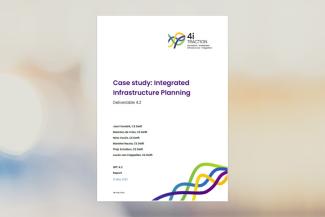
Vendrik, J., de Vries, M., Voulis, N., Nauta, M., Scholten, T., van Cappellen, L. (2023): Case Study Integrated Infrastructure Planning. 4i-TRACTION Deliverable 4.2. CE Delft; Delft.
Report: Integrated Infrastructure Planning
This case study investigates the policy instrument of Integrated Infrastructure Planning, with a focus on transnational energy infrastructure.
Timely roll out of the necessary energy infrastructure is a key factor in the transition to a climate neutral energy system and reaching the climate goals. This requires proper and integrated infrastructure planning processes, also on European level.
Benefits of transnational energy infrastructure
Realisation of transnational energy infrastructure requires significant investments, but also leads to benefits for the energy system. The main benefits of transnational energy infrastructure investments are higher utilisation of renewable energy production. This leads to less curtailment and less gas-based generation, reduction of greenhouse gas emissions and increased security of supply within the EU. If investment planning is done efficiently, the benefits of investments in transnational energy infrastructure outweigh the costs and consequentially lead to lower overall energy costs and total energy system costs.
Current policies are insufficient
The report describes current EU policies regarding transnational energy infrastructure and discusses which gaps exist in the light of reaching a climate neutral European energy system. With current policies and governance, the planning of transnational energy infrastructure mainly takes place at Member State level. Some processes take place at EU level to incorporate a pan-European view on the roll-out of interconnections, but these are either non-binding or non-decisive. All formal competences for the planning and realisation of transnational energy infrastructure are situated at Member State level, with Transmission System Operators, national or local governments and national regulators. This also means that investments in interconnections are made separately by a large number of TSOs, rendering the decision making process rather fragmented.
A pan-European view on energy infrastructure planning
A pan-European view on transnational energy infrastructure planning is necessary for the realisation of an efficient climate neutral European energy system. This pan-European view should be guaranteed within policies and governance, in contrast to the existing non-binding processes.
Different options exist to improve current policies to guarantee the incorporation of a pan-European view on transnational energy infrastructure planning and investment decisions and lead to a more comprehensive and transformative approach. This comprehensive approach can, in principle, be implemented most effectively by transferring all competences regarding planning of transnational energy infrastructure to EU level.
However, realisation of a EU centralised approach is challenging and has drawbacks. Therefore, a more middle-of-the-road approach with fewer barriers would be to impose binding requirements to member states for the development of transnational energy infrastructure. However, with this policy option decision-making remains fragmented.
Rigorous changes may be necessary
Rigorous changes in legislation are expected to be necessary to adequately face the enormous task of reaching climate neutrality in the EU in less than three decades. Even though transferring all competences for transnational energy infrastructure to EU level may seem politically unattainable right now, rigorous and transformative changes like this may be necessary in the transition toward climate neutrality. The policy option with a single pan-European entity that is responsible for all transnational energy infrastructure investments fits well within a policy framework in which all resources within the EU are used to make sure the climate targets are met.